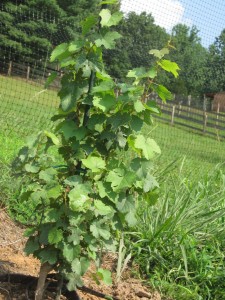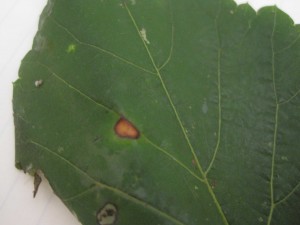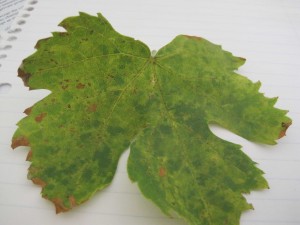Tag: potato leafhopper
Vineyard Diseases and How to Cure Them
It’s scary to think about how many predators are out there waiting to attack the average vineyard. Birds, bees, foxes, rabbits, deer – Even Bambi can’t be trusted! – and a host of insects, from the potato leafhopper to the Japanese Beetle, want nothing more than to devour the vines, from their leaves on down to the grapes themselves. And that isn’t counting the fungi.
Last weekend at Monticello, Gabriele Rausse taught a class on vineyard diseases that was as wonderful (Gabriele and Monticello) as it was depressing (birds, bees, deer – you get it). The predatory Bambis of the world can be controlled fairly easily with fences. Birds, which begin taking a serious look at the vines after the sugar level rises almost to the point where it is time to harvest, can be scared away with foil streamers that are hung at intervals so that they fly in the breeze.
But fungi are a different story. They require lots of attention, and no small amount of chemicals. Unlike California’s wine valleys, where vines grow in dry heat with cool nights and little rain, Virginia vineyards are subject to heat, humidity and lots of rain. (Especially this year.) All of which provides a good, but hopefully not perfect, environment for a variety of fungal diseases to take root, so to speak. Black Rot, Downy Mildew, Powdery Mildew, Botrytis (and not the good kind of Botrytis, the “noble rot” responsible for Sauternes) and many other diseases just lie in wait for the conditions that enable them to ruin a vineyard.
So, that means spraying. Not just once or twice, but routinely, weekly and especially after three-quarters of an inch or more of rain. We’d love to go organic and dispense with the spraying, but it’s not possible in Virginia, at least not with vines. I don’t know if other fruits and vegetables can be grown in Virginia without spraying, but I’m inclined to think you can’t. Certainly, Virginia Tech’s Cooperative Extension service web site has tons of information about spraying programs for fruit and vegetables, which implies that fungicides are needed. But whatever the case for other types of fruit, wine grapevines require spraying.
That’s also true in other environs. Gabriele said they had to spray in his native Italy (the Veneto region), for example. So, it’s not a crime to spray. But it does make for a lot of work and expense, one of the reasons, in fact, that Virginia wine is so expensive.
And by the way, if you're interested in this subject, the best source of information availale, at least for Virginia viticulturists — and probably for grape farmers everywhere — is Mizuho Nita's blog. It's a must-read for anyone interested in growing wine grapes in Virginia.
Spraying is a discipline, and it's one of those things you have to do when it's needed, whenever it's needed, with no exceptions. Hard work, for sure. But I think it's worth it, and that the end result of all that pest management will be wine that is truly memorable.
The Potato Leafhopper Saga, Part II
Continuing the Potato Leaf Hopper saga, which strictly speaking hasn’t yet risen to the level of a saga, it looks like we’re making some progress. We evaluated our Nelson County vines over the weekend and are reasonably happy with what we saw. The new leaves looked healthy and disease free, and the vine seems to be growing nicely (well, with the exception of one vine, which appears to be the runt of the litter).

- This Cab Franc vine is growing slowly, but it appears healthy. No holes in the leaves from Leafhoppers, and good color.
Most important, the Potato Leafhoppers appear to have all but vanished. Two weekends ago, they were gone. Last weekend, we found one or two, and removed them by hand. We’ll check again next weekend, but for now, the Vineyard Goddess is resting easy, and we doubt we’ll need to hit the vines with another dose of pesticide.
Now, I’m sure some of you are wondering if I was being a bit overly dramatic. You’re thinking, yeah, the Potato Leafhopper is probably some kind of mean little insect, Bob, but in a world full of pests, it’s pretty small fry. It’s not like Donald Trump parked himself in your vineyard and let the property go to seed. (Actually, that would be the vineyard some 30 minutes down the road.)
But trust me, the Potato Leafhopper is a pest to be taken seriously. Consider this statement from the Compendium of Grape Diseases, an authoritative guide to vineyard problems: “Few insects have plagued grape growers during the last century more than leafhoppers.”
According to the Compendium, the potato leafhopper breeds in the Gulf Coast states over the winter, then grow in number through March and April before migrating northward, distributing themselves over most of the U.S. The leafhopper harms grapes “by mechanically injuring and blocking vascular tissue, by injecting toxic enzymatic secretions, or by a combination of both mechanisms.” You ever see Trump blocking any vascular tissue?
In any event, it appeared that the Leafhopper was doing considerable damage to the vineyard, and we were ready to go to war with it. With luck, we might have put that pest behind us, which will free us up to deal with the myriad other problems that plague vineyards. Like overly acidic soil. Or Downey Mildew. And someday, maybe, birds, foxes and bees. Stay tuned for the next report from the front.
The Vineyard Goddess and the Potato Leafhopper
The Vineyard Goddess was not happy.
Our Nelson County vineyard was looking decidedly unhealthy. The leaves on the vines were pale, and they were full of holes. My wife, the Vineyard Goddess, spent hours inspecting the vines, looking through books, and searching the Internet for answers. Finally, she decided to email a photo of the not-so-healthy leaves to a Virginia Tech grape pathologist.
Virginia Tech’s Agricultural Research and Extension Center is a wonderful resource for Virginia Viticulturists, and they could not be more helpful. Within a few hours, she had an answer. It was most likely an insect that was doing the damage.
Although we hadn’t seen any bugs in the vicinity, the Vineyard Goddess decided to stake out the seven vines until she found what she was looking for. She didn’t have to wait long. There, on our Mammolo Toscano – I could almost hear her shriek, “not the Mammolo!” – were two tiny green bugs. They moved fast, but not as fast as the Vineyard Goddess.
Pinching one between thumb and forefinger, she carried it back to the house, combed through our viticulture books as well as the Internet, and made a positive ID. It was a Potato Leafhopper. We had never heard of a Potato Leafhopper, and had no idea why it had given up on potatoes and turned to our vineyard for nutrition. But it had.
It turns out that the Potato Leafhopper not only likes to munch on grape vine leaves, but it produces a toxic saliva that can dry up the leaves and mimic drought conditions. That explained a lot, including the curled leaves on our vines
VG immediately dusted the vines with a cure-all pesticide, and we both crossed our fingers.
Stay tuned for the next report from the front lines of our battle with this pest.





Recent Comments